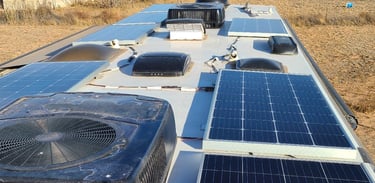Sunlight Means Power
February 28 - The Mind - Solar Panels - #26-2024
MINDDISCOVERIES
AL
2/29/2024


My first experience with solar power was a simple calculator. It had a small solar panel to power it. I remember it was wonderful never needing to replace batteries. Now we have 8 rigid and 3 flexible panels that power our home most of the time. It had me wondering how they are built, how they work, and how they came to exist.
Solar energy products and usage is advancing at an amazing rate in the last few decades, but it had much simpler beginnings. The earliest recorded uses was back in the 7th century B.C., when they realized concentrating the sun’s rays through magnifying glass would create fire. In a more passive use, the ancient Romans built south-facing sunrooms on their buildings in Europe, and the Anasazi (ancestors of the Pueblo people) in America lived in south-facing cliff dwellings to capture warmth from the sun.
All of that seemed lost until long after the Dark Ages, when solar energy as we think of it today was born. Photovoltaic effect, which solar panels are based on, was first discovered in 1839 by a French physicist, Edmond Becquerel. It is a process that produces voltage or electrical current when exposed to light or radiant energy. He observed that platinum electrodes coated with silver chloride and placed in an acidic solution, increased their electricity generation when exposed to light. He realized the excited state of the electrons allowed them to move freely through the material, thus creating current.
In 1883, Charles Fritts invented the first solar panel using a thin layer of selenium coated with an extremely thin layer of gold. It was only 1% efficient, and selenium was too expensive for it to be of practical use, but it was the start. Then, in the 1950’s, employees at Bell Labs produced the first modern solar panel. They created it using the first silicon solar cells, and used them to power electrical devices. This was the big breakthrough that made our solar power system possible. Silicon solar cells are still the primary ones used today.
So, what is a solar panel? It is a collection of photovoltaic cells (solar cells) that are each comprised of a thin semiconductor wafer made of two layers of crystalline silicon. Each of those cells have been combined with other elements to give one layer a negative charge and the other one a positive charge. It is usually phosphorus that they add to give a negative charge, and boron that results in a positive charge. Each layer has a metal conductive plate on one side, and the junction between these layers is where the electrical field is created. They energized when sunlight shines on them, and the electrons are freed from the atoms within the wafer. Those electrons are the set in motion creating an electrical current, thus, sunlight is harnessed as energy. These cells are usually protected from mechanical damage and moisture by securing them between glass. Most modules are rigid, but semi-flexible ones based on thin-film cells are also available. The cells are usually connected electrically in series, one to another to the desired voltage, and then in parallel to increase current. The power (watts) of the individual cells and the panel is the voltage (volts) multiplied by the current (amps), and depends both on the amount of light and on the electrical load connected to the module.
In the beginning, solar energy was only viable in outer space, where other forms of energy were too costly, but as research accelerated in the 1990’s, it has become more mainstream. The 2000’s brought warnings of climate change and fossil fuel depletion, which spurred more development in renewable energy. Scientists continue to work hard developing PV (photovoltaic) modules that are more efficient, and cheaper, making solar a stronger contender against fossil fuels.
The sun is one of the world’s greatest natural energy sources. It is said there is enough potential energy reaching the earth each hour to easily meet our global energy needs. It is fully sustainable and doesn’t release harmful greenhouse gases into the atmosphere. For myself, I know is it lets us stay in free camping areas while we travel around the country seeing new places, and provides us with enough sustainable energy for our refrigeration, cooking, and entertainment needs.
This morning, Tom showed me an article he read a few days ago about what is happening with residential solar power in Arizona. It is unsettling to read that they are singling out residents with solar systems for higher rates. This article was from a solar publication, so it may have some bias to it. I will have to do some more research on it to know how true it is. If true, it feels unfair and punitive against those that have only wanted to do something good.
I am curious what you think about solar systems and if you have or are considering implementing one. We are thinking that we would include a solar system in our future home. It makes sense to take advantage of the free energy delivered to our planet by the sun. It’s an investment up front, but it would pay dividends for years. We would love to be off-grid as much as possible, using a combination of solar, wind, and geothermal energy to take care of our needs.
Share your comments on Facebook or email us at roadfronts@gmail.com
Subscribe for monthly updates
Current location:
